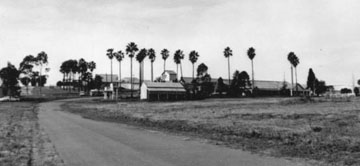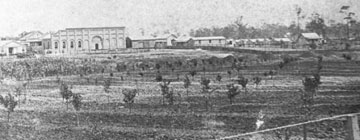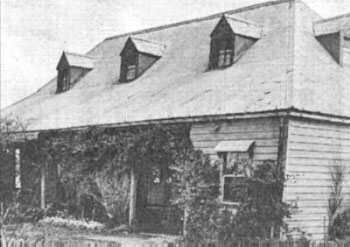In line with the rest of the Western Sydney Local Government areas, Blacktown's economy has evolved from a mainly rural, agriculturally based economy to one dependent on commercial, manufacturing and light industrial activities.
AGRICULTURE
The first attempt at agricultural activities in the area was based at the foot of Prospect Hill, where 14 men were granted land in February 1792 [Ryan: p.4ff]. While the land is listed as being granted in 1792, it would appear that they had settled there earlier, since Watkin Tench writes of visiting the area in December 1791, commenting that the settlers lived in "wretched hovels", that the maize that was planted looked "not very promising", the "small patches of wheat · are miserable indeed", the "greatest part of the land I think but indifferent", water had to be fetched over distances of up to a mile and a half, and that some of the settlers "were in a state of despondency". The settlers all complained of being robbed by runaway convicts, and had been attacked by natives on more than one occasion [Tench: p.250 -252]. Given that some of the settlers had little prior experience with agriculture (there were two weavers, two seamen, and a watchmaker), it is little wonder that there was some despondency!
Due to difficulties of growing grain, much of the land in the area was turned over for the grazing of cattle and sheep. Governor King planned to have tracts of land reserved in each area to enable the common grazing of animals or for the grazing of government owned stock. By 1803 the Rooty Hill Stock Farm (an area approximating the current Blacktown City Council boundary) was set aside by the Government for grazing of government herds. The Rooty Hill Stock Farm was reduced in size over the years, finally closing in 1828. The Prospect Common was established in 1804, but the land was gradually granted away, and it was no longer in existence by 1829.
Some of the larger landholders of the mid 1800's were involved in breeding horses - this pursuit is reflected in Blacktown City's coat of arms. In 1831, both Robert Lethbridge of "Flushcombe" and William Lawson of "Veteran Hall" were advertising their horses as studs - Lethbridge's "Bay Camerton" was considered to produce the best stock in the colony. [Cox, 1983: p.13-16]. The East India Company grazed horses at Bungarribee, a property in Doonside, and Walter Lamb was breeding trotters at first "Greystanes", Prospect and then "Woodstock", Rooty Hill. During a drought in 1876, Lamb sold off 400 head of horses and moved a further 100 to Goulburn or Molonglo [Olson: pp14-25].

Minchinbury Winery in the 1970s
Grape vines and wineries were important industries in the area, the largest vineyard being located in Minchinbury - Dr. Charles McKay purchased the property in 1859 and developed it into vineyards and cellars. Over the next 2 decades, Dr. McKay bought many neighbouring properties and in 1881, he put all of his land up for auction. At this time, the land did not sell and it wasn't until 1895 that James Angus bought all of McKay's properties.
Penfolds Pty. Ltd. purchased the winery and vineyards in 1912. Most of the existing buildings at the winery were probably added while under the ownership of Penfolds. In 1898, during Angus' winemaking years, the vineyards suffered a viral disease that destroyed the vines. While the Minchinbury vineyard managed to withstand this setback, many other smaller vineyards in the area did not. New vines were planted and grew until 1962 when soil erosion made them useless. Small acreages along Wallgrove Road were planted with vines, and grapes from areas around Australia were brought in to enable wine production to continue. Minchinbury Winery became famous for its champagne - the "Great Western" label reflects the area's involvement. Penfolds stopped operations at the winery in 1978.
Land use can be gauged by the occupations listed in the Electoral Roll for Blacktown, 1899 - 1900. There are over 100 men who list their occupation as "fruitgrower", or "orchardist", 60 call themselves "farmers", and there are only 6 poultry farmers. This trend continues, and the 1933 Census lists 1138 men as being involved in agricultural occupations (dairy farming, mixed farming, etc.). Given that most people lived close to their work, we can assume that these men were working locally.
In the late 1880s, Walter Lamb set up a canning factory at Plumpton (known as Woodstock). He subdivided his land (which had fruit trees growing on it), offering it for sale in small acreages and undertaking to buy back all the produce. The depression of 1889/90 and the competition of Victoria canneries caused Lamb to declare bankruptcy in 1893, and while the cannery still operated until 1912, it was not the prosperous enterprise that Lamb had planned.
In the 1920s there was a push towards poultry farms - the Soldier Settlement at Seven Hills was based on raising poultry (the scheme was unsuccessful, and the area became the Grantham Poultry Research Station). Small farms in Quakers Hill were also used for the raising of poultry. The association with poultry continues to this day, with the large poultry concerns of RedLea and Inghams located in the area.
Dairy and poultry farms and market gardens still exist in the area today, although the demand for land within the metropolitan area has placed pressure on agricultural land.
INDUSTRY
As indicated above, there were some grand schemes stemming from agriculture in the 1800s - the establishment of the Minchinbury Winery, The Riverstone Meatworks, and the Woodstock Fruit Cannery. However, industrial activities have really only become important in the later period of the area's history.

Woodstock Fruit Cannery
An industrial register for 1976 shows that in 1954/55, there were 87 industrial establishments in the Blacktown Municipality. By comparison, in 1976 there were 286.
In 1960, 300 acres of land had been set aside for industrial development, and only 137 acres were in active use. A report of the day outlines some of those industries:
Present district industries include Mephan Ferguson Pty Ltd, in Sunnyholt Road, Blacktown, where the largest cement lined pipes in the State are manufactured, which were used in the construction of new pipe lines from Prospect to Pipe Head etc.; Carrier Air Conditioning at Seven Hills, the largest factory of its kind to be found in the Southern Hemisphere; Australian Sewing Cottons in Station Road, Seven Hills, the most modern thread factory in Australia, where the thread used daily on two machines would stretch from Sydney to Perth; Electric Power Transmission's plant at Marayong, which has produced many of the television towers, bridges and high tension towers, today dotting the face of Australia; Lightweight Aggregate Pty Ltd, a new Australian industry in Doonside Crescent Doonside, opened in November 1958 by the Governor-General, Sir William Slim; and Chief Clothing Company, Blacktown, manufacturers of quality men's clothing. [Wailes: p.39]
An article in the Sydney Business Review in 1995 reported that Blacktown City Council was looking at increasing the amount of industrial land due to the demand from major national and international companies wanting to relocate to the area [p.40]. Some of the companies who have a presence in the area include Woolworths, with a major warehouse and road transport terminal at Minchinbury; Nestle Australia with a warehouse and cool store distribution facility at Arndell Park; FJ Walker Foods, Davids Holdings and Wattyl Paints all with premises at Kings Park; Sony Music with a CD manufacturing plant at Huntingwood; and Arnott's with a factory at Huntingwood [Blacktown City Council, 1997a].
Blacktown City has ten industrial estates, all with excellent links to the Great Western Highway, M2 and M4 motorways and other regional roads, and rail links. Blacktown City Council has the largest serviced Industrial Land Area within Sydney, totalling 1,230 hectares.
COMMERCE
Early commercial ventures in the Blacktown area consisted of inns, providing accommodation, and sustenance for travellers through the area. Along the Great Western Road there was the Fox Under the Hill at Prospect, erected in 1830. It served as a changing place for horses for coaches heading for the Bathurst goldfields, was supposedly a hide-out for Jack Donahue, bushranger, and operated as a tollgate. It closed in 1875, and for many years the building was used as the clubhouse for the Fox Hills Golf Course.

Fox Under the Hill Inn
At one stage there were four inns at Colyton accommodating travellers along the road. William Dean's land grant at Eastern Creek was conditional on him providing services to travellers. He was granted a licence to operate his inn, "The Corporation Inn", also known as the "Red Lion", on the eastern side of Eastern Creek bridge on the Western Road, in 1820. Another inn was opened at Eastern Creek, run by Thomas Pike, in 1857 - "The Old House at Home".
Still operating as an hotel today is the "Imperial Hotel" at Rooty Hill. It opened its doors to the public on August 12, 1890, and had been built for Mr Frank Weston, of "Horsley". In his speech Weston remarked on the changes in Rooty Hill - only ten years previously there had been only six houses, now there were "16 private houses, three grocers' shops, three butchers, one baker, one blacksmith, and one milliner". The hotel lost its licence to sell beer in 1936, becoming known as Penfold's Wine Bar. In 1977 it was purchased and restored, reopening as the Imperial Hotel in 1982.
Blacktown can claim the first Westfield Shopping complex in Australia. Opening in 1958, the "modern" idea of bringing shops together under one roof was a modest venture by today's standards. Westfield Plaza was built in two stages and when completed in 1959, it consisted of 15 shops and car parking facilities. The original buildings still stand, the "Winn's" Department store now housing the Max Webber Library. It is planned that part of the complex will be demolished to make way for an expansion to the existing Westpoint shopping complex.
The second "Black Stump" restaurant to be established in Australia was at Blacktown, in 1972 - an "Oakleigh" New York Cut steak cost $2.85.
Today, there are many major commercial sites in the area. Blacktown City's commercial centres house the regional headquarters and service centres for national and international companies as well as government organizations including the Roads and Traffic Authority, TAFE and the Departments of Health and School Education.
Blacktown City Centre and Mount Druitt Town Centre are the flagships of commerce and retailing in the City. Both centres are easily accessible by road and comprehensive public transport services and offer a wide range of retail, commercial and community services. Westpoint Blacktown and Mount Druitt Marketown, the major shopping centres, have been continually upgraded and extended since opening in the early 1970s.
The City's district centres are located at Plumpton, Quakers Hill, Seven Hills and Riverstone, and a new district centre is planned for the Parklea Release Area. There are numerous local centres operating in the City, all within easy walking distance of the residential areas they serve. Single shop mixed businesses (or corner stores) provide daily convenience shopping within the City's residential zones. Still more retail and commercial facilities are found in the more established business centres such as Doonside and Rooty Hill.
In a category of its own is Parklea Markets, which has become the largest indoor market area in the Southern Hemisphere and attracts 90,000 visitors each weekend.
BIBLIOGRAPHY
Blacktown City Council (1997a) Blacktown City's Commercial Centres
Blacktown: BCC.
Blacktown City Council (1997b) Blacktown City's Industrial Estates Blacktown: BCC.
Liston, Carol (1986) Draft Blacktown heritage study: thematic history. Jonathan Falk Planning Consultants.
Ryan, R J (ed) (1981) Land grants 1788 - 1809. Sydney: Australian Documents Library.
Tench, Watkin (1979) Sydney's first four years. Sydney: Library of Australian History.
Wailes, Olga (ed) (1960) Blacktown railway centenary 1860 - 1960: a century of progress. Blacktown: n.p..
Cox, Dennis "Sires of the season, 1831" in Blacktown and District Historical Society Quarterly Journal. 4 (3), November 1983, pp 13 - 16.
"Investors can't get enough of Blacktown" Sydney Business Review 15 February, 1995. p.40
Olson, Dianne "Walter Lamb at Greystanes" in Blacktown and District Historical Society Quarterly Journal. 5 (4), January 1985, pp 14 - 25.